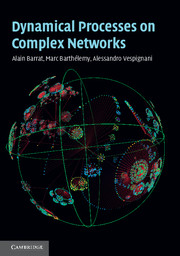Book contents
- Frontmatter
- Contents
- Preface
- Acknowledgements
- List of abbreviations
- 1 Preliminaries: networks and graphs
- 2 Networks and complexity
- 3 Network models
- 4 Introduction to dynamical processes: theory and simulation
- 5 Phase transitions on complex networks
- 6 Resilience and robustness of networks
- 7 Synchronization phenomena in networks
- 8 Walking and searching on networks
- 9 Epidemic spreading in population networks
- 10 Social networks and collective behavior
- 11 Traffic on complex networks
- 12 Networks in biology: from the cell to ecosystems
- 13 Postface: critically examining complex networks science
- Appendix 1 Random graphs
- Appendix 2 Generating functions formalism
- Appendix 3 Percolation in directed networks
- Appendix 4 Laplacian matrix of a graph
- Appendix 5 Return probability and spectral density
- References
- Index
7 - Synchronization phenomena in networks
Published online by Cambridge University Press: 05 September 2012
- Frontmatter
- Contents
- Preface
- Acknowledgements
- List of abbreviations
- 1 Preliminaries: networks and graphs
- 2 Networks and complexity
- 3 Network models
- 4 Introduction to dynamical processes: theory and simulation
- 5 Phase transitions on complex networks
- 6 Resilience and robustness of networks
- 7 Synchronization phenomena in networks
- 8 Walking and searching on networks
- 9 Epidemic spreading in population networks
- 10 Social networks and collective behavior
- 11 Traffic on complex networks
- 12 Networks in biology: from the cell to ecosystems
- 13 Postface: critically examining complex networks science
- Appendix 1 Random graphs
- Appendix 2 Generating functions formalism
- Appendix 3 Percolation in directed networks
- Appendix 4 Laplacian matrix of a graph
- Appendix 5 Return probability and spectral density
- References
- Index
Summary
Many natural systems can be described as a collection of oscillators coupled to each other via an interaction matrix. Systems of this type describe phenomena as diverse as earthquakes, ecosystems, neurons, cardiac pacemaker cells, or animal and insect behavior. Coupled oscillators may display synchronized behavior, i.e. follow a common dynamical evolution. Famous examples include the synchronization of circadian rhythms and night/day alternation, crickets that chirp in unison, or flashing fireflies. An exhaustive list of examples and a detailed exposition of the synchronization behavior of periodic systems can be found in the book by Blekhman (1988) and the more recent reviews by Pikovsky, Rosenblum and Kurths (2001), and Boccaletti et al. (2002).
Synchronization properties are also dependent on the coupling pattern among the oscillators which is conveniently represented as an interaction network characterizing each system. Networks therefore assume a major role in the study of synchronization phenomena and, in this chapter, we intend to provide an overview of results addressing the effect of their structure and complexity on the behavior of the most widely used classes of models.
General framework
The central question in the study of coupled oscillators concerns the emergence of coherent behavior in which the elements of the system follow the same dynamical pattern, i.e. are synchronized. The first studies were concerned with the synchronization of periodic systems such as clocks or flashing fireflies.
- Type
- Chapter
- Information
- Dynamical Processes on Complex Networks , pp. 136 - 159Publisher: Cambridge University PressPrint publication year: 2008



